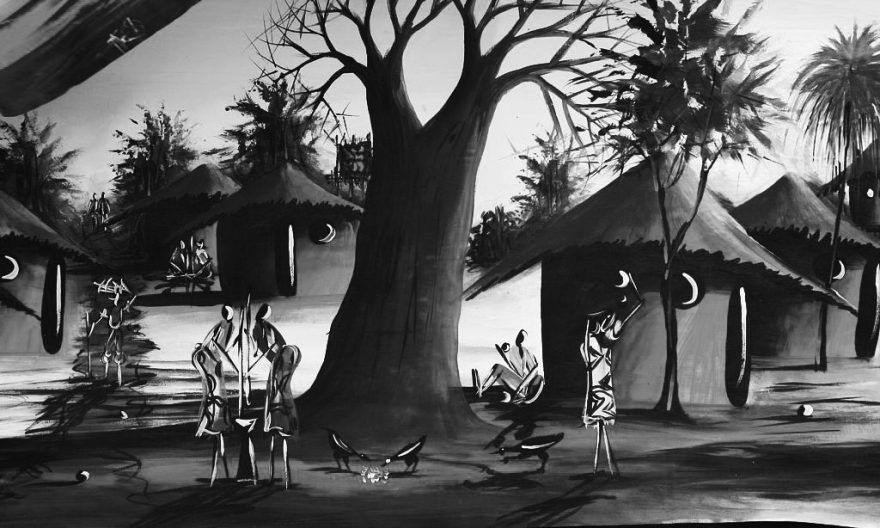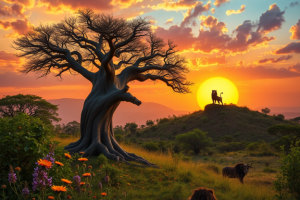
The just passed year 2023 was characterized as the year Africa blossomed with many works of literature and music, songs and dances. It was main a year of literary arts when young and veteran authors published their works or in case of plays they presented them for stage performance. Although African artists will continue in the new year, 2024 is expected to be a year of African arts exhibitions as disclosed by Ebony, a prominent black magazine exclusively dedicated to black arts.
Ebony magazine columnist Delaina Dixon recently wrote an article entitled, “Get your culture on. The Best Black Artists and Exhibits to see this fall and winter” in which she calls upon exhibition visitors in the following terms, “Buckle up art enthusiasts! This year is primed to be another year of groundbreaking brilliance from Black artists. A tapestry of Black exhibitions and experiences will be explored nationwide, from African art from middle ages to the personal art collection of Ebony cover star Swizz Beatz and Alice Keys.
The works featured bring joy, beauty and unbridled imagination to every installation. From soul-stirring canvases to immersive installations, prepare to be moved, inspired and even challenged by these exhibitions that promise to ignite conversations and leave you breathless with their sheer creative force.”
As indicated above, last year was marked by a high-caliber literary outputs by African writers in particular dealing with the challenges faced by the continent in these troubled times and every author tried to highlight in their works the old themes of colonization, neocolonialism as well as themes of post-globalization turmoil that impact on individual African countries and the continent at large.
African writers continue to produce new works as young talents are emerging every year to the shock and astonishment of European and American book publishers and the writing community at large. Yet, literary masterpiece are not produced every year because writing and publishing books take relatively long time and arduous and sustained efforts. Meanwhile, other Black and African artists who have been engaged in other art forms such as painting, sculpting and other forms of African and Black arts are said to shine in 2024 with their unprecedented exhibitions that are expected to display new canvases, sculptures and masks so far unseen by the global art community. Long marginalized or ignored by the mainstream art market, the new and old African arts is going to see a year of unprecedented international attention and market opportunities that were not so far properly exploited by the artists although Black art is on the ascendency everywhere.
For that matter, the most popular art form in Africa is said to be, “sculptures and masks arguably the most widely recognized types of African art, textile design, and manufacturing have also been an important aspect of art making throughout the continent’s history. African artistic productions like sculpting and mask making have been long ignored or hidden in museums within the continent and in Europe or America where they are proudly exposed as properties of these museums while in reality most of them were stolen from the continent during the colonial era and afterwards.
According to one report, “The Salisbury African Galleries in the British Museum display 6000 objects from the largest permanent collections of African arts and culture in the world. The three permanent galleries provide a substantial exhibition space for the museum’s African collection comprising over 20000 objects. The availability if a huge amount of arts in Africa and outside the continent has never deterred Black artists from contributed to this expanding bodies of works.
African art is not fully known and appreciated. However, a closer look would suggest that the continent has a proud artistic legacy. “Africa is home to a thriving and energetic contemporary art culture. Painting, sculpture, metal art, gun art, photography, installation art, contemporary textile and thread art, recycled art, printmaking and mixed media.” African art has not only a very long tradition dating back to many centuries. It is also known for its diversity and the most intriguing fact about African art is that what is known as rock art was the earliest form of African art, much of African sculpture was historically in woo and that traditional religions are extremely influential on historical African art form.
According to Wikipedia, the art exhibition is traditionally the space in which art objects meet and audience. The exhibit is universally understood to be for some temporary period unless, as is occasionally true, it is stated to be a permanent exhibition.” The art works may be presented in museums, art halls, art clubs or private art galleries, or at some place the principal business of which is not the display or sale of art, such as a coffeehouse. As to where the first art exhibition took place, it is important to note that, “The year 1914 was a turning point for African art in America when two New York galleries introduced African sculpture to their audiences.”
What is however astounding in this process is the fact that while Africa has long been the major source of arts and culture in the world and the custodian of the most ancient arts and cultures, it had not enjoyed the opportunity to display its artistic treasures here at home in Africa.
Generally speaking, there are two types of exhibition. One of the main type of exhibition is called solo exhibition -this refers to the display of artwork from a single artist, usually the most famous pieces by the artist. Another type of exhibition is collective exhibition which displays the works of several artists. Meanwhile the difference between art gallery and art exhibition should be made clear.
As far as African art exhibitions are concerned, the National Museum of Art in the US has the largest collection of African art works and is the only national museum in the US dedicated to the collection, exhibition, conservation and study of arts of Africa. The largest art fair in Africa is the Investec Cape town Art Fair which is the largest art fair with over 100 exhibitors, 25 000 visitors and 6500 VIPs. It offers a platform for galleries, collectors, curators, and artists from around the globe to create connections at the forefront of contemporary art.
As indicated above, there are many artistic events in the pipeline which are planned to take place and that will feature old and contemporary African and Black arts in 2024.
African arts exhibitions around the world are already scheduled according to sources. Contemporary African Art Fair is pleased to announce the return of its event, scheduled to take place from February 8-11, 2024 at la Mamounia and DaDa in Marrakech. The Marrakesh Contemporary African Art Fair is believed to be a significant development and that it’s expanding its physical footprint in Marrakesh by inaugurating a second location in DaDa, understanding to deepening its commitment to deepening its involvement in the dynamic Marrakesh art scene. This expansion is comes in recognition of the fair’s phenomenal success.”
According to the article by Delaina Dixon, we quoted above, the following Black art exhibitions are scheduled to take place at different dates and venues in 2024. The first exhibition is called The Futuristic Ancestry: Warping Matter and Space-time (s) which is a photographic exhibition that will take place in New York. This is also an exhibition that will be stage by Jossepha Ntjam who had her first multinational solo show in the US featuring selection of new works, including biomorphic sculptures, photomontages printed on Plexiglas and aluminum.
Another art exhibition that will take place in Detroit, US this is called Reemergence: Black Cinema (1898-1971). It will take place at the Detroit Institute of Art in Michigan honoring the legacy of African-American filmmakers and actors from the dawn of cinema to the aftermath of the American civil rights Movement. We can keep on enumerating the many art exhibitions on African and Black arts that will take place this year. These exhibitions are dealing with modern art and their subject-matters and mediums of expression are rather sophisticated or stylish or post-modern in a way.
Some of them like the Harlem Renaissance and Transatlantic Modernism are historic and groundbreaking exhibitions meant to establish the Harlem Renaissance as the first African-American-led movement of international modern art, featuring 160 works from black artists portraying everyday modern life in the new black cities during the great migrations. The exhibition is expected to take place February 25 through July 2024.
These events will no doubt be interesting to Africans and black people in the Diaspora who have witnessed firsthand the artistic expressions black painters, filmmakers and others. This will also be a moment of reflection on the current status of African and Black people all over the world that will give inspiration to upcoming new generation of artists who will articulate future visions at the centre of which will be the future total emancipation of black people everywhere in the world.
BY MULUGETA GUDETA
THE ETHIOPIAN HERALD THURSDAY 18 JANUARY 2024




